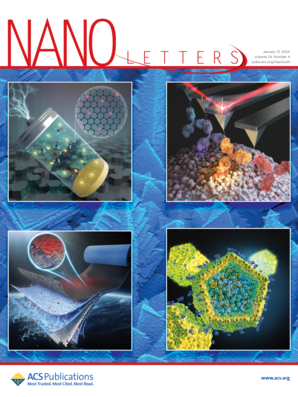Jahn–Teller-Driven Electronic Modulation of Bio-Heterojunction for Wound Regeneration after Postoperative Tumor Resection
IF 9.6
1区 材料科学
Q1 CHEMISTRY, MULTIDISCIPLINARY
引用次数: 0
Abstract
Abundant ·OH, 1O2, and ·O2– provide an efficient methodology for rapid tumor and bacteria killing, whereas a limitation focuses on the catalytic efficiency. Thus, Jahn–Teller-driven electronic modulation of a bioheterojunction (bioHJ) platform is developed for the remedy in diabetic infectious wound regeneration after postoperative tumor resection. The bioHJ is composed of MoTe2/MnO2 and glucose oxidase (GOx). GOx depletes glucose to H2O2, which intercepts their glucose metabolism. The H2O2 can be further converted into highly lethal ·OH owing to peroxidase-mimetic activity via the Jahn–Teller effect, while GSH can be consumed due to its GPx-mimetic activity. Both of which can be further amplified upon NIR irradiation as NIR-activatable enzyme-mimetic activities. In vivo studies in a subcutaneous tumor model and infectious model authenticate the ability to kill tumor, defeat bacterial infection, and accelerate wound regeneration. This work enlightens a powerful platform for postoperative infectious wound regeneration of tumor resection using an engineered bioHJ.

jhn - teller驱动的电子调制生物异质结用于肿瘤切除术后创面再生
丰富的·OH, 1O2和·O2 -为快速杀死肿瘤和细菌提供了有效的方法,然而限制集中在催化效率上。因此,jhn - teller驱动的电子调制生物异质结(bioHJ)平台被开发用于治疗糖尿病感染性伤口术后肿瘤切除后的再生。bioHJ由MoTe2/MnO2和葡萄糖氧化酶(GOx)组成。GOx将葡萄糖消耗为H2O2,从而阻断它们的葡萄糖代谢。通过jhn - teller效应,H2O2可以进一步转化为高致死的·OH,而GSH则可以通过其模拟gpx的活性被消耗。这两种酶在近红外照射下都可以进一步扩增为近红外激活的酶活性。在皮下肿瘤模型和感染模型的体内研究证实了其杀死肿瘤、击败细菌感染和加速伤口再生的能力。本研究为肿瘤切除后应用工程生物hj进行感染性创面再生提供了一个强有力的平台。
本文章由计算机程序翻译,如有差异,请以英文原文为准。
求助全文
约1分钟内获得全文
求助全文
来源期刊

Nano Letters
工程技术-材料科学:综合
CiteScore
16.80
自引率
2.80%
发文量
1182
审稿时长
1.4 months
期刊介绍:
Nano Letters serves as a dynamic platform for promptly disseminating original results in fundamental, applied, and emerging research across all facets of nanoscience and nanotechnology. A pivotal criterion for inclusion within Nano Letters is the convergence of at least two different areas or disciplines, ensuring a rich interdisciplinary scope. The journal is dedicated to fostering exploration in diverse areas, including:
- Experimental and theoretical findings on physical, chemical, and biological phenomena at the nanoscale
- Synthesis, characterization, and processing of organic, inorganic, polymer, and hybrid nanomaterials through physical, chemical, and biological methodologies
- Modeling and simulation of synthetic, assembly, and interaction processes
- Realization of integrated nanostructures and nano-engineered devices exhibiting advanced performance
- Applications of nanoscale materials in living and environmental systems
Nano Letters is committed to advancing and showcasing groundbreaking research that intersects various domains, fostering innovation and collaboration in the ever-evolving field of nanoscience and nanotechnology.
 求助内容:
求助内容: 应助结果提醒方式:
应助结果提醒方式:


